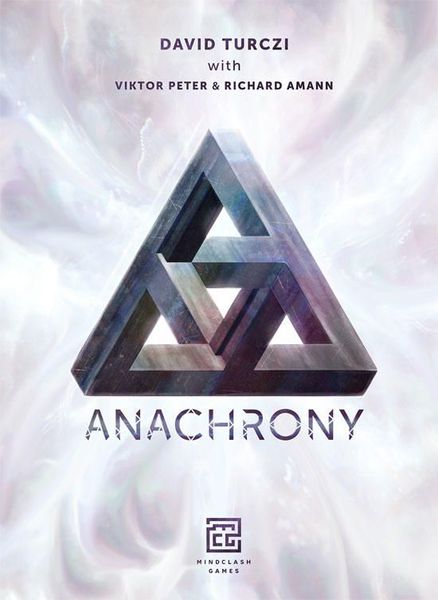- Learning time
- 90 minutes
- First play time
- 180 minutes
Anachrony
Designed by: Dávid Turczi
A far-distant future, a capital city surviving in a perilous landscape… you, the players, are the hardy souls in the harsh environment struggling to survive, when suddenly a visitor arrives from the future – yourself! A worried yourself, with a warning: an asteroid is going to hit the planet very soon, and before that happens you must build a safe new haven for the citizens of the capital. Fortunately, your future selves can also send people and materials back through time to assist you: a scientist, for instance, with a case of neutronium. The catch being of course that when you reach the future, you need to pay off these tense-travelling debts to avoid paradoxes developing…
Anachrony is a complicated beast and attempting a rules-explanation here would be futile – you need the board and kaleidoscope of pieces in front of you to make sense of it all. But we can talk you through the basics. Anachrony uses a system called worker-placement, where you have several workers and take turns assigning them to spaces on the board. In games like Stone Age and Agricola you might send a worker to get wood, another worker to get stone, and then a third to use the harvested materials to build a house, which will score you some points. Though the materials are a little more vowel-heavy it’s not that different here: the spaces for workers do similar things as in those simpler games – gather resources, build, hire more workers and so on. But there are not-inconsiderable catches too…
Firstly, the land between your fledgling city and the capital is a perilous landscape, remember, so anyone you send to the capital needs to wear an exo-suit for protection – and they’re not always as available as you’d like. Secondly, workers usually return from their assignments tired out, and it costs you water – the closest thing the game has to a currency – to refresh them. Or you could simply force them to go to work, which costs no water at all, but adversely affects morale and causes a worker to leave.
Where Anachrony stands out from a number of other worker-placement games however, is in the facilitation of time-travel. In every round, players can request personnel or resources from the future, but run the risk of – if they’re the greediest – picking up paradoxes as a result. Three paradoxes result in an anomaly, which is so disconcerting for everybody it affects the construction of your town: the only way to be rid of it is by sacrificing resources and sending a brave – or unwitting – worker to their doom… however, if you build the right buildings, you can begin sending goods back through time and removing the potential for these chronological spanners in the works. You’ll also get better at time travel, which scores you points at the end of the game.
After four rounds of scrambling to build, the asteroid hits and the game suddenly changes up about three gears. It’s time to get as many people out as you can, using a newly-available evacuation action. This is a potentially big swing in your favour: every player has their own criteria for what they need to evacuate and how they can maximise the return in doing so. Crucially, you can only evacuate once in the entire game, so timing is everything. What’s more, as the capital crumbles around you, six previous worker spaces become one-use-only: as soon as anybody uses them, they’re gone forever. If all six go, the game will end, and if not there is a maximum of three rounds post-asteroid.
Scoring is carried across a number of criteria: the buildings in your city, your workers’ morale, your ability to time-travel, plus some game-end bonuses that vary from game to game. Paradoxes and anomalies count against you!
The guru's verdict
-
Take That!
Take That!
Not actually that much at all. You can and will be beaten to spots on the board, and beaten to the construction of certain buildings , including the valuable SuperProjects. But these moments are as often inadvertent as deliberate... Unless... if you play the game a lot, familiarity with the components and workings will allow players more scope to make spoiling moves...
-
Fidget Factor!
Fidget Factor!
Very high on a first play, because the game has a zillion icons to reference and clarifications will be needed across a number of points. But like most games, knowing the landscape reduces this down-time considerably, and after a couple of plays the box's seemingly-ludicrous claim of playtime (30mins per player!) will start to come into view as merely optimistic.
-
Brain Burn!
Brain Burn!
To some degree, your strategies are dictated by what faction you play: each has a distinct criteria towards scoring evacuations, and that gives you an objective to work towards. How you do that is more the question, as you could borrow big from the future and build fast, or play with more fiscal responsibility and have less debt to worry about later. Around that central question are a number of tactical concerns too - not least turn order, which can be key.
-
Again Again!
Again Again!
Well, you do need to enjoy the various spinning wheels Anachrony provides in four types of workers, five types of buildings, four different resources, multiple opportunities to loan from your future self and the (variable) game-end rewards. Assuming you do, however, Anachrony has much in-built variability and certainly provides a sense of spectacle. It also provides an additional 'Doomsday' scenario in the box to mix in with the base game, and a 'bot' for solo play.















Sam says
Every game demands a kind of investment on the part of the players; to learn, to understand, to play with an obligation to be competitive (or co-operative) in order for everything to function. The simpler a game is, the less investment required. More complex games, however - and Anachrony most definitely skews toward that end of the spectrum - demand more of you. Learning the rules takes a good hour or two to read everything, with all the pieces out in front of you to make sense of it all. For a lot of folk, Anachrony will simply be too dense and inaccessible from the start of that journey. But if you're willing to undertake it, then there is a certainly plenty here - various factions, various powers, various strategies to pursue. For me, however, bluntly put the time investment in Anachrony wasn't as rewarding as a number of other longer games: the intuitive play of Caverna, say, the highly interactive Eclipse or the absorbing puzzles of games such as Trajan. It's a little of all those things while mastering none, and it feels complex for complexity's sake. Although I liked the cleverness of some of the systems at play - the time-travelling, the need to suit up workers - I finished every game I played of it with a sense of relief, which I don't think is great as the predominant take-away from any experience, especially when it's as long as this one. That all said, if you like a complex game and the setting appeals to you, there are certainly folk out there who will (and do) love this.